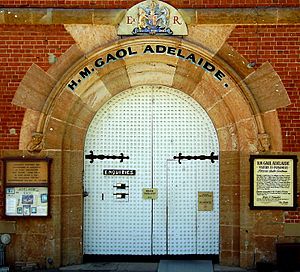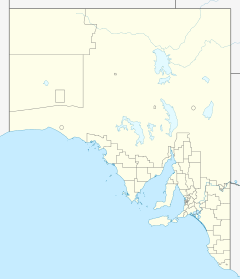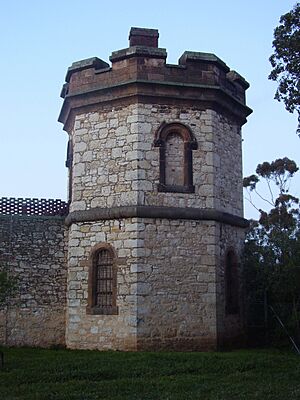Adelaide Gaol facts for kids
 |
|
| Location | Adelaide, South Australia |
|---|---|
| Coordinates | 34°55′03″S 138°35′06″E / 34.9176°S 138.5849°E |
| Status | Closed |
| Opened | 1841 |
| Closed | 1988 |
| Managed by | Department of Environment, Water and Natural Resources |
| Website | http://www.adelaidegaol.sa.gov.au/ |
The Adelaide Gaol is a historic former prison located in Adelaide, South Australia. It was the first permanent prison in South Australia. The gaol operated for 147 years, from 1841 until 1988.
Today, the Adelaide Gaol is one of the two oldest buildings still standing in South Australia. It now serves as a museum, a popular tourist attraction, and a place for special events.
Contents
Building South Australia's First Prison
When the first settlers arrived in South Australia in 1836, there wasn't a proper prison. Any people who broke the law were kept on ships like the HMS Buffalo.
Soon, a temporary lock-up was built in 1838 near the Governor's home. It was made of wood, but one room was stone, called the 'stone jug'. This temporary prison quickly became too crowded and was not very secure. Prisoners could easily escape because the walls were old and weak.
Governor George Gawler was very concerned about the poor conditions. He decided that a permanent, secure prison was urgently needed.
Designing the New Gaol
In 1840, George Strickland Kingston was asked to design a new, strong prison. His plans were based on a famous prison in England called Pentonville. The new Adelaide Gaol was designed to hold 140 prisoners.
However, the construction of the gaol faced many problems. Governor Gawler changed the plans several times, making the building much more expensive. The cost grew from an estimated £17,000 to about £40,000. This huge cost was a big problem for the new colony. It even caused a financial crisis and many people went bankrupt.
The arguments over the cost led to Governor Gawler being called back to England to explain his spending. Originally, the gaol was meant to have four fancy towers, but only two were ever finished.
Life and Changes at Adelaide Gaol
The first prisoners, who were people owing money, moved into the new Adelaide Gaol on Christmas Eve, 1840. More prisoners followed in early 1841 as the building was completed.
William Baker Ashton became the first governor of the gaol. For many years, people often called it Ashton's Hotel.
Helping Prisoners
From 1867 to 1869, Mary MacKillop, who later became Australia's first saint, regularly visited the gaol. She and her helpers from the Sisters of Saint Joseph cared for both male and female prisoners. They also helped women after they were released from prison.
Escapes and Improvements
The first attempt to escape happened in 1854, but the prisoners were caught. The first "successful" escape was in 1897 when three prisoners got away, but they were later recaptured.
Over the years, the gaol had many changes. In the 1950s, after public complaints about poor conditions, the prison was renovated. New toilet blocks were added, and a doctor started visiting daily. Before this, prisoners had to prove they were very sick to see a doctor. In the 1960s, a shower block and a bakery were built.
Closing Down
In 1969, all female prisoners were moved to a new facility. Throughout the 1970s, parts of the old buildings were updated.
The Adelaide Gaol finally closed in 1988. The remaining prisoners were moved to newer prisons. After its closure, the gaol was taken over by the South Australian Department for Environment and Heritage. It was then reopened as a museum and tourist attraction.
Inside the Gaol: Layout and Daily Life
The Adelaide Gaol has a special "radial plan" design. This means all the cell blocks and exercise yards can be reached from one central point, called "The Circle."
Prisoner Yards
- Yard 1 was built in 1850 for women prisoners. Later, it was used for other prisoners, like those with illnesses.
- Yard 2 was a three-storey cell block that also housed women originally.
- Yard 3 was first for people who owed money. It later became a women's yard and now has an Induction Centre where new prisoners were processed.
- Yard 4 had two-storey cell blocks for male prisoners. The last three cells in one block were for prisoners sentenced to death.
- Yard 6 was for prisoners waiting for their trial. It was the first part of the gaol to be emptied when a new Remand Centre opened.
- The New Building was built in 1878 by prisoners themselves. It was made to hold more people. This building also had a permanent gallows.
Cells usually had buckets for toilets, which were emptied and cleaned in the yards.
A Day in the Life of a Prisoner
Life in the gaol followed a strict routine:
- At 7 am, breakfast was served in the cells.
- At 8 am, cells were inspected, and toilet buckets were emptied.
- Most of the day, inmates walked in the yards, talked, or played cards because there were few other activities.
- Lunch was at 11 am, and dinner was at 4 pm.
- Lights were turned out at 10 pm.
- Prisoners were counted at the start and end of every meal break.
Prisoners were given a black felt jacket and work boots. They received fresh clothes twice a week. They also got a small amount of tobacco, papers, and matches each week. Some prisoners volunteered for jobs like cleaning or maintenance to break up the routine. The only entertainment was a library of donated books and decks of cards. Prisoners could write two letters a week, but writing materials were otherwise banned.
Between 1841 and 1988, about 300,000 people passed through the gaol. In the 1960s, the gaol held up to 440 prisoners at once, meaning some cells had three people.
Archaeological Discoveries
In 2007, an exciting discovery was made at the gaol. A volunteer fell through some old floorboards, revealing the remains of a previously unknown building. This led to a two-year archaeological investigation.
It was thought that South Australia's first settlers might have camped near the River Torrens. The dig at the gaol site showed that this might have been their original camp!
Archaeologists found five different layers of history:
- Level one (before 1836): Evidence of Indigenous people hunting, fishing, and camping. Stone tools were found.
- Level two (1836 to 1840): Evidence of the first settlers' tents and mud huts. Animal bones, ceramics, and even a child's tooth were discovered.
- Level three (1840 to 1847): Evidence of the area being a work site for the gaol builders. Metal scraps and broken bricks were found.
- Level four (1847 to 1900): The original wooden floor of a building used as six cells for female prisoners. Needles, pins, and thimbles were found in the floor cracks.
- Level five (1900 to 1988): The current building, which was used as a recreation area and tea room. Cutlery and tea bags were found.
These excavations are now open for visitors to see, and some of the items found are on display.
Famous People Connected to the Gaol
- Elizabeth Woolcock
- Rupert Maxwell Stuart
- Bevan Spencer von Einem
- Valerio Ricetti
- Sarah Francisco
Visiting Adelaide Gaol Today
The Adelaide Gaol is now a museum where you can learn about its past.
Educational Tours
The museum offers guided tours that last about 60 minutes. These tours are interactive and teach visitors about what life was like for prisoners. Students can explore the courtyards and cells, touch artifacts like handcuffs, and learn about South Australia's history.
Public Access
You can visit the gaol for self-guided tours every day from 10 am to 4 pm. For those interested in spooky stories, ghost tours are also available at night!
Adelaide Park Lands and Dame Roma Mitchell Gardens
The Adelaide Gaol is located within Park 27 of the Adelaide Park Lands. Inside the gaol walls, you'll find the Dame Roma Mitchell Gardens. Until 1988, prisoners tended these gardens.
Today, volunteers look after the gardens. They grow fruits, vegetables, and flowers that are donated to help people who are homeless or in need.



